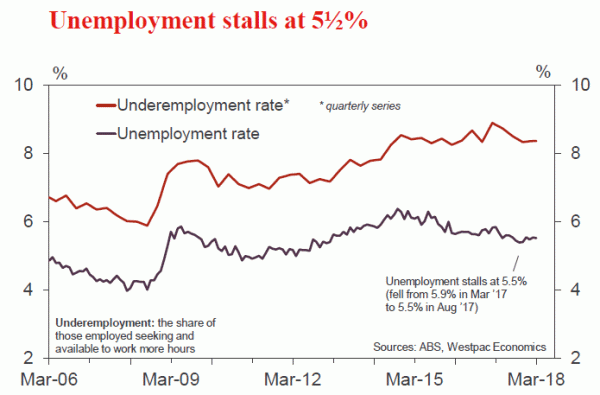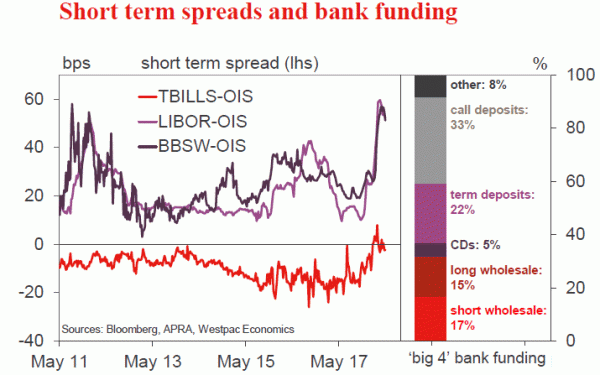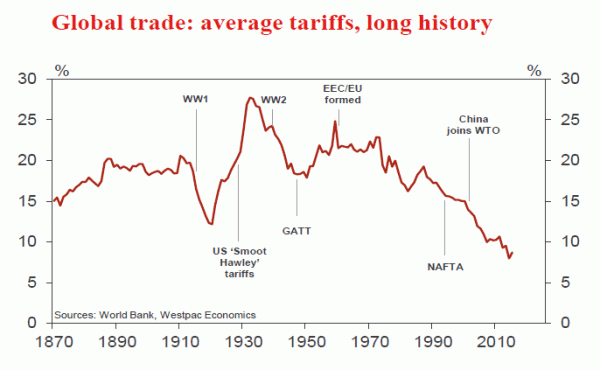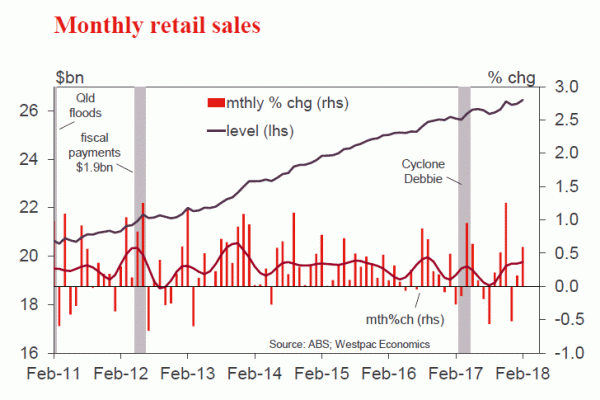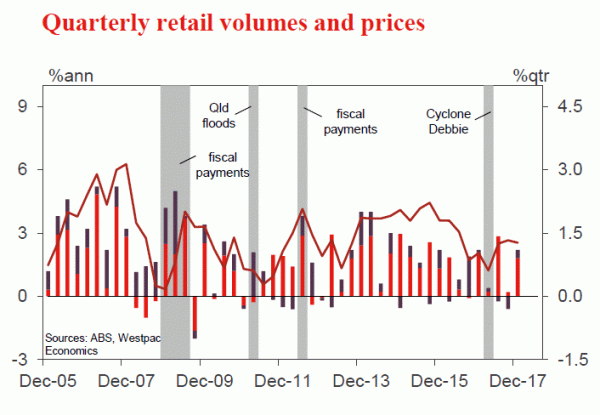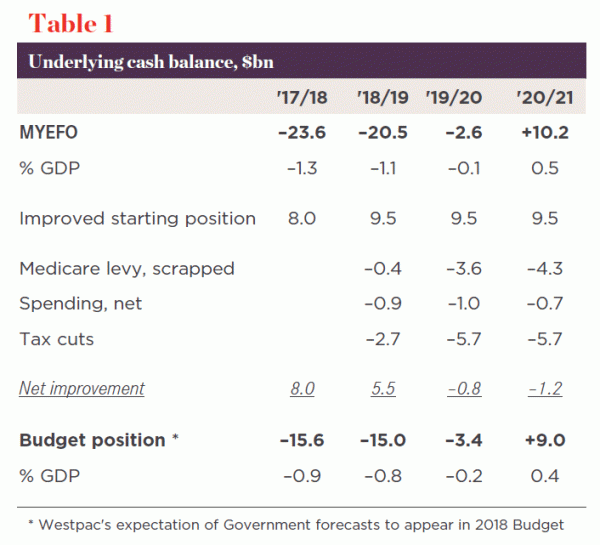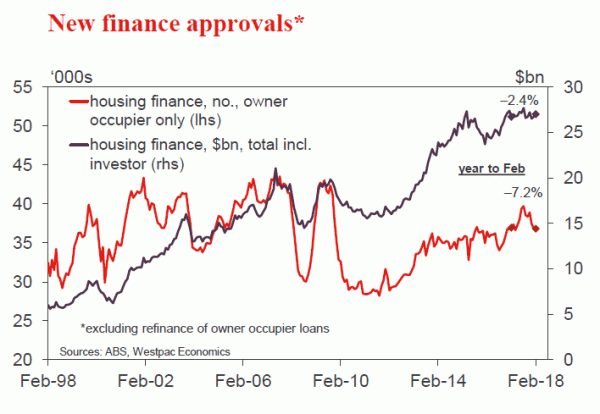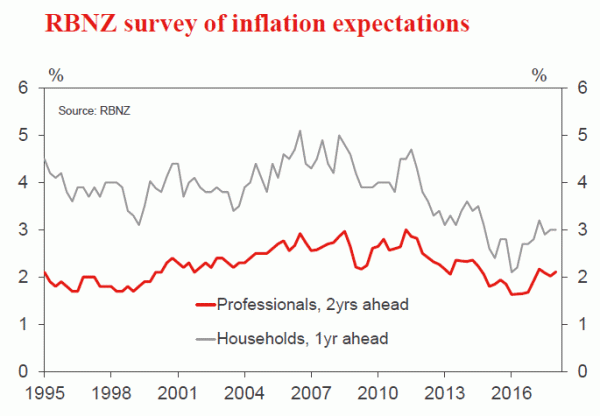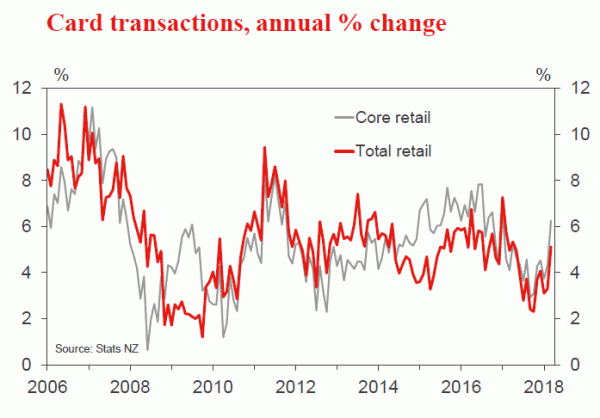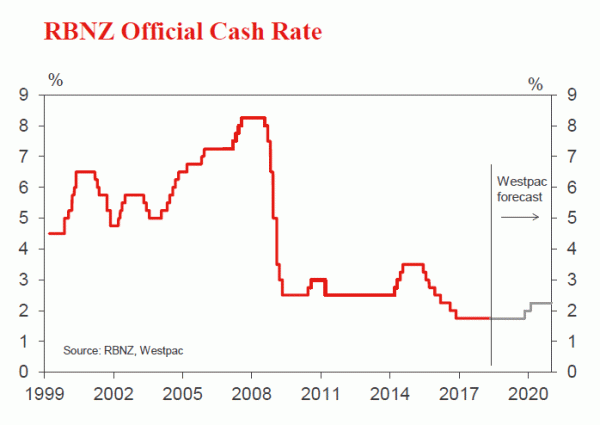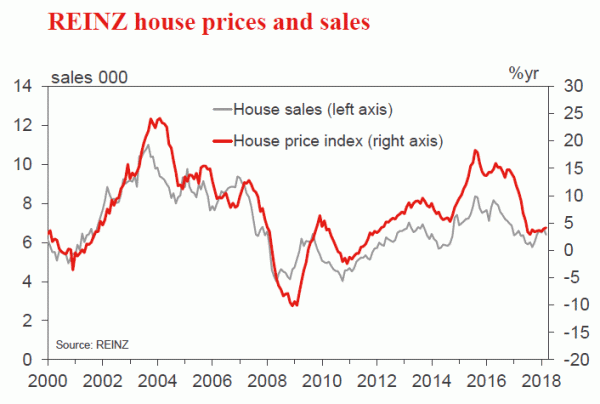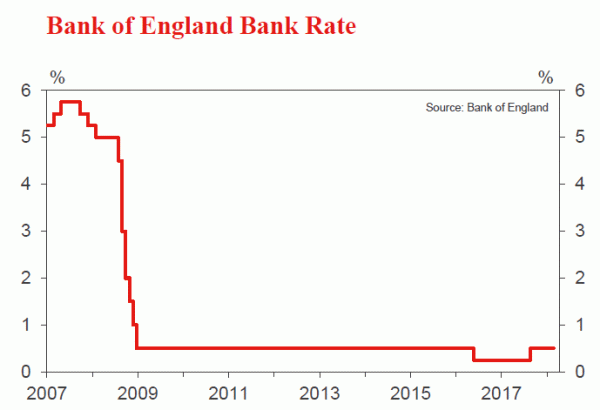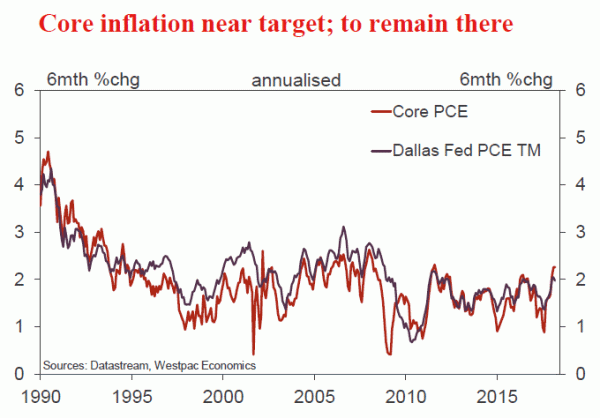Week beginning 7 May 2018
- RBA firmly on hold as bank funding costs rise.
- Australia: Federal Budget 2018, retail sales, housing finance, NAB business survey.
- NZ: RBNZ OCR decision, inflation expectations, card spending, house sales & prices.
- China: credit growth, trade balance, FDI, CPI.
- Euro Area: Sentix investor confidence.
- US: Fed Chair Powell speaks, CPI.
- Central banks: BOE, BNM, BSP.
- Key economic & financial forecasts.
Information contained in this report current as at 4 May 2018.
RBA Firmly on Hold as Bank Funding Costs Rise
We have just received an update on the Reserve Bank’s growth forecasts in the May Statement on Monetary Policy (SoMP).
The growth forecast has been held at 3¼% in 2018 and 3¼% in 2019. Given the various vacillations about this forecast over the last three months (higher than 2017; above trend) we are not imbued with a feeling that the Bank is particularly confident about this highly optimistic view. Recall that Westpac’s view is that growth in 2018 will be 2.7% and in 2019 it will slow to 2.5%.
The other interesting forecast in the May SoMP is underlying inflation in 2018. In February, the forecast was 1.75%, below the 2-3% target band and following 1.6% in 2016 and 1.8% in 2017 – hardly a vote of confidence in the 2-3% target band. The May SoMP nudged this up to 2%.
The case for rate hikes has taken a further blow over the course of recent months.
Firstly, the labour market is slowing down and the unemployment rate seems to be stuck near 5.5%. Employment growth in 2017 was 3.4%. Three month annualised employment growth in 2018 has slowed to 1.2%. The unemployment rate fell from 5.9% to 5.6% through to September last year, but has made no further progress. Reflecting the slowdown, the RBA raised its 2018 forecast for the unemployment rate from 5¼% to 5½%.
In April, the Governor referred to tightening financial conditions due to the rise in short-term USD interest rates. This represents a genuine tightening of financial conditions and the reasons for this tightening are important to understand, since there is little chance of these conditions easing significantly in the foreseeable future. Essentially there have been changes in both the supply and demand for short term USD paper.
On the supply side the US Treasury has been charged with funding a big uplift in borrowings as the US debt ceiling was lifted; tax cuts and spending increases filter through; and the US Federal Reserve continues to shrink its balance sheet by not reinvesting maturing securities. Treasury bills have traditionally traded at rates below the OIS (the imputed rate based on the expectation of Fed policy movements). This margin has generally been around 10-15bps.
Bank borrowing is generally priced relative to Treasury bills, so if these rise in rate so will bank borrowing rates (LIBOR).
There has also been a tax change in the US which means foreigners with USD assets who fund them in other currencies through a parent company (and then convert in the forwards market) no longer get a tax deduction. To qualify they must now borrow in USD. That means there has been a sharp increase in the supply of private sector issuance of USD borrowings in the US market, putting further upward pressure on short term US rates.
On the demand side we have seen a sharp reduction in the investment ‘appetite’ of major tech companies which had accumulated around USD$1.5tron in profits held offshore. These companies were ready investors in short term USD paper, putting downward pressure on LIBOR. With the US tax changes whereby companies can now bring these accumulated profits back onshore without paying the 32% tax rate, their appetite for bank paper has waned considerably.
Banks that issue short term paper into the USD market are now having to pay a higher yield to attract investors. The Australian banks have been large borrowers in that market given their strong needs for offshore funding. Markets are efficient, so a rise in the cost of USD borrowings also impacts the cost of AUD borrowings in the domestic market, i.e. AUD investors are also aware of banks’ funding costs offshore and can extract a higher rate. For them, investing in USD paper and converting back to AUD paper is a comparable investment. This rise in USD funding costs is also affecting foreign subsidiaries who typically fund in USD and convert back to AUD.
These ‘forces’ (Treasury bills; tax changes in the US; tech companies moving their liquidity; domestic investors; foreign subsidiaries) have pushed the margin between the risk free rate and the banks’ borrowing rate from 25bps to around 55bps.
This effect has impacted all banks’ wholesale funding costs and the funding costs of businesses. Little wonder markets continue to push back on the timing of the RBA’s much awaited rate hike.
As has been the case since mid-2017 Westpac continues to expect the cash rate to be on hold in 2018 and 2019.
The week that was
The RBA has been front and centre this week, with the May meeting followed by a speech by Governor Lowe, then the release of the latest Statement on Monetary Policy (SoMP). Changes to the SoMP forecasts were subtle. Growth in 2018 and 2019 was held at 3.25%, while 2018 inflation was edged up to 2.00% (from 1.75%) following six months of 2% annualised core inflation. In contrast, the unemployment rate forecast for December 2018 was nudged up to 5.50% from 5.25%.
Broadly this implies that the RBA continue to expect growth to move above trend over the coming year and remain there. As a consequence, wages and inflation growth should accelerate – though on this point, Governor Lowe made clear in his speech that there has been very limited evidence of improvement to date. The edging higher of the unemployment rate forecast is simply a reflection of softer employment growth in February and March. They still believe the unemployment rate will move lower come 2019.
Westpac’s view remains more circumspect. We see growth holding a little below trend on average through 2018 and 2019 and, as a result, anticipate little progress on wages and inflation growth. Combined with the broad-based softening of the housing market, there is little to no justification for a rate hike in 2018 or 2019. In terms of the risks: to the upside the labour market will be key; to the downside the effect of macro-prudential regulation on credit growth and housing is crucial.
Now as we end this week, for Australia, all eyes shift to next Tuesday’s Federal Budget. Often key initiatives are floated ahead of the event, but in this instance little information is available. We know that strength in commodity prices and employment growth have delivered a much-improved starting point for the Budget projections. For the most part, it seems that this windfall will be spent on personal tax cuts and the cancellation of the planned increase in the Medicare levy surcharge (previously announced to fund the NDIS). Additional spending on infrastructure; health; aged care; education and the environment is also expected.
Westpac will provide a comprehensive review of the Budget next Tuesday night and the morning after.
Turning to the US, the FOMC also met this week. No change was expected. Instead the focus was on the language used, with participants wanting to know if an expected hike at the June meeting would be followed by another one (or two) moves before year end. On the whole, the Committee held to a positive view of the outlook, although the weakness in consumption in Q1 was given greater credence. We (and arguably the FOMC) are relying more on government spending and investment to drive growth than the consumer. Hence the Committee will only become concerned if the consumer weakness of Q1 becomes entrenched.
On inflation, there was an important change, with the symmetric nature of the 2.0% medium-term target being emphasised. After such a long period of underperformance, there is a willingness amongst policy makers to run the economy ‘a little hot’. More broadly, it is fair to say that risks to the inflation outlook are the same as those for the overall economy – balanced. For us, this statement suggests that the FOMC will take their time with rate increases, with two more to come in 2018 and another two in the first half of 2019. This is the point where our and the FOMC’s views diverge however: we foresee financial conditions cutting off growth; they expect momentum to hold up. Higher productivity and consequent wage gains are needed if the FOMC’s 3.00%+ terminal rate is to be achieved.
For Asia, China’s official PMI’s and the Markit measures have all been released this week. In China, momentum remains robust, though external demand looks to be easing at the margin. Efficiency and profitability also remain a key focus amongst manufacturing and service firms, with employment continuing to lag activity. In the rest of Asia, developed nations look to have been harder hit by softer conditions in Europe and, to a lesser extent, the US. Japan is an exception, with further strength reported in April. Across developing Asia, the outcomes were more robust. For most, domestic demand is in good shape.
For those that would like to delve deeper into the world of economics, our latest Market Outlook publication will be released today. Covering off on key developments across the global economy and financial markets, it provides valuable insights into current circumstance and the outlook. It also includes our latest growth; foreign exchange and interest rate forecasts.
Chart of the week: Trade tariff history
Average trade tariffs have been on a declining trend since the 1970s. While we have seen a lift from time to time – most notably the 1980s – the direction has been overwhelmingly down.
As we go to press, delegates from the Trump administration are in China for negotiations following the recent inflammation in trade relations. Our monthly Market Outlook includes a review of the trade saga as it stands and assesses how it relates to Australia’s exports.
New Zealand: week ahead & data wrap
This week Stats NZ delivered its battery of labour market data relating to the March quarter. It arguably deepened a key mystery – why is wage growth so low when employment is strong?
The unemployment rate fell to a fresh nine-year low of 4.4%. That was on the back of ongoing employment gains, although the pace of employment growth has slowed over the past year. Despite falling unemployment, wage growth remained muted. The Labour Cost Index (LCI) showed just a 0.3% rise for the quarter. The annual rate was 1.9%, but excluding the impact of last year’s pay settlement for aged care workers, the annual increase would have been 1.6% – effectively the same rate of increase that we have seen for the last several years.
In contrast to the subdued wage growth story in the LCI, the QES measure of average hourly earnings has picked up strongly in the latest quarter, and over the last year. However, we would put less weight on this series. It has always been more volatile than the LCI (and was affected more by the aged-care workers’ settlement), and the recent growth is arguably a correction from a very weak patch a year earlier.
The labour market surveys came ahead of next week’s Monetary Policy Statement (MPS), which will be the first under the Reserve Bank’s new mandate to contribute to maintaining maximum sustainable employment and avoid unnecessary volatility in employment. The RBNZ may consider unemployment of 4.4% evidence that employment is currently at, or even beyond, the maximum sustainable level. This is based their assertion that the non-inflationary rate of unemployment is 4.7%, and their forecast that the long-run average rate of unemployment will be 5%.
But there is a great deal of uncertainty about where employment stands relative to the maximum sustainable level. The lack of a pickup in wage growth suggests that employment is still short of the sustainable maximum. The labour underutilisation rate of 11.9% argues in the same direction. Other evidence points in the direction of employment being at or beyond the maximum sustainable level – surveys show that firms’ difficulty finding labour is at a cyclical extreme, and the employment to GDP ratio is extremely high.
These issues will be hotly debated at the RBNZ, and will be discussed in detail in the MPS. However, we do not think that the move to considering the labour market will prompt a change in the OCR outlook. The RBNZ may well conclude that the labour market does not need assistance in the same way as inflation needs a boost. In that sense, moving to a dual mandate weakens the case for keeping the OCR low. However, there have long been considerations outside of inflation that have made the RBNZ wary of lowering the OCR too far. Most notably, the RBNZ didn’t want to risk inflaming the housing market. Shifting the focus to the labour market probably won’t increase or decrease the RBNZ’s caution about keeping the OCR low.
In terms of the inflation outlook, recent developments have probably been to the positive side. The exchange rate has dropped sharply below the RBNZ’s forecast, the housing market has been stronger than the RBNZ expected, and export commodity prices have risen instead of falling as the RBNZ anticipated. That is more than enough to offset the fact that GDP growth has probably been weaker than the RBNZ expected in the six months to March.
However, the recent rise in bank bills (the interest rates at which banks lend to one another) relative to the OCR is a spanner in the works. The risk is that this will spark off a round of independent mortgage rate increases. The RBNZ will probably want to see how this issue pans out before actually changing the OCR outlook.
Bringing all of this together, the RBNZ is likely to leave the OCR unchanged relative to the February MPS, meaning it will continue forecasting no change in the OCR until mid- to late-2019. If there is a change in OCR outlook it will be small, and in the direction of earlier hikes.
More uncertain is how the RBNZ chooses to communicate the OCR outlook. For over a year now it has repeated the same bottom-line: “Monetary Policy will remain accommodative for a considerable period. Numerous uncertainties remain and policy may need to adjust accordingly.” The new Governor might want to stick with that phrase to emphasise continuity for markets. Or he may want to emphasise the change in regime by changing the wording. We have no way of telling which it will be, but what we can say is that a change in phraseology from the RBNZ will not necessarily be a signal to markets.
The final interesting feature of this week’s labour market data was that after years of strong growth, employment in the construction sector has flattened out. This matches a general decline in business confidence in the construction sector observed over the past year and reaffirmed in this week’s ANZ business confidence survey. This week’s building consents data rose strongly, but the strength was restricted to the volatile Auckland apartment building sector. The general trend in consents over the past seven months has been sideways.
It is hard to tell what has caused this general flattening off in residential construction activity. It may represent a reduction in demand for building, but that would be surprising given the housing shortages that are manifest in Auckland and one or two other parts of the country. The other possibility is that construction is beset with some form of inability to grow, rather than an unwillingness. Labour shortages are probably not the constraint – we have noticed that job ads in construction have also come off. More likely, construction firms and developers are finding it difficult to access finance, and are having difficulty turning a profit with costs rising as they are. This is an issue we will look more deeply into, given that our long-run forecast is for ongoing gradual growth in construction activity.
Data Previews
Aus Mar retail trade
May 8, Last: 0.6%, WBC f/c: 0.2%
Mkt f/c: 0.2%, Range: -0.1% to 0.6%
- Retail sales improved in Jan and Feb (+0.2% and +0.6% respectively) after a 0.5% fall in Dec that had followed a patchy second half to 2017. The detail was also mostly positive with the Feb gain led by solid rises in ‘discretionary’ store types. Notably, online sales continue to see strong growth, albeit from a low starting point.
- Indicators are more mixed for March. Consumer sentiment softened after a sharemarket sell-off and increased concerns about the outlook for the economy and jobs. Retail responses to private sector business surveys also point to a softening in sales although these have provided conflicting guidance in recent months. On balance we expect March to show renewed headwinds with a sub-par 0.2% gain
Aus Q1 real retail sales
May 8, Last: 0.9%, WBC f/c: 0.8%
Mkt f/c: 0.5%, Range: -0.5% to 1.3%
- After stalling in Q3, retail volumes rebounded 0.9% in Q4, rounding off a stop start year for retail. Volume gains have also been alongside aggressive price discounting – non food retail prices down 0.9%qtr, and 2%yr, 2017 marking the biggest annual price decline since the early 2000s when a rising AUD was generating significant falls in imported goods prices.
- The Q1 update should show a further rise but at a slower pace. Nominal sales are on track to be up about 0.7% for the quarter vs 1.1% in Q4. Retail prices have again moved lower, the Q1 CPI detail pointing to a decline of around 0.2% (although this understated price weakness in Q4). Overall the mix points to a 0.8% rise in real retail sales.
Aus 2018 Federal Budget, AUDbn
May 8, Last: -15.6(e), WBC f/c: -15.0
Mkt f/c: -15.0, Range: -23.0 to -7.5
- Federal Budget 2018 will reveal an improved budget position relative to the December MYEFO largely reflecting upside on jobs growth and commodity prices in 2017/18.
- For 2017/18, the deficit is expected to improve by $8bn relative to MYEFO, upgraded to $15.6bn from $23.6bn.
- For 2018/19, after factoring in the potential impact of new spending and personal income tax cuts, the deficit is some $5.5bn lower than in MYEFO, at $15.0bn (0.8% of GDP).
- As to the timing of the return to surplus, this is likely to remain in 2020/21, to the tune of $9.0bn, broadly in line with the MYEFO forecast of $10.2bn.
- Net debt levels remain manageable at an expected $351bn (18.4% of GDP) at June 2019.
- For more detail, see our preview bulletin.
Aus Mar housing finance (no.)
May 11, Last: 0.2%, WBC f/c: -3.0%
Mkt f/c: -1.5%, Range: -3.0% to 2.5%
- Australian housing finance approvals were essentially steady in Feb, the number of owner occupier approvals dipping 0.2% and the value of investor finance up 0.5%.
- Industry figures point to a sharp fall in owner occupier approvals in March – we expect the official figures to show a 3% drop. Housing markets remained soft through the month with auction clearance rates around long run average levels in Sydney and Melbourne and prices continuing to slip lower. Buyer sentiment has steadied having lifted off its 2017 lows but remains downbeat by historical standards. Some tightening in lending criteria may also be impacting new finance activity.
NZ Q2 RBNZ survey of inflation expectations
May 8, Two years ahead, last: 2.11%
- The latest RBNZ expectations survey was held soon after the March quarter inflation result, which saw annual inflation dropping from 1.6% to 1.1%. However, it’s not clear that expectations will follow the CPI downwards. Some of the March quarter softening in inflation was due to special factors, such as the partial removal of tertiary study fees. In addition, there have been some well publicised price increases (e.g. petrol), as well as growing concern about Government policy and wage costs.
- Inflation expectations in this and other surveys have lifted from the lows we saw in 2016/17 and have now flattened off at levels around the RBNZ’s 2% target mid-point.
NZ Apr retail card spending
May 9 Last 1.0%, WBC f/c: -0.1%
- Retail card spending was stronger than expected in March, rising by 1% over the month. In part, that strong result was a rebound from earlier weather related weakness. Spending also appears to have received a boost from Easter holiday leisure activities and the recent firming in the housing market (which tends to affect spending on durable items).
- With weather and holiday related volatility dissipating, we expect to see a modest 0.1% easing in retail spending in April. However, given the solid gains earlier in the year and low level of retail price inflation, we wouldn’t describe that as weak. Spending continues to be supported by strong population growth, low interest rates, and the recent firming in the housing market.
RBNZ OCR and Monetary Policy Statement
May 10 Last 1.75% WBC f/c: 1.75%, Mkt f/c: 1.75%
- This will be the Reserve Bank’s first policy announcement under its new Policy Targets Agreement and under Governor Adrian Orr. We don’t expect a change in the OCR outlook. But if there is a change, it will be in the direction of slightly earlier hikes than previously signalled. Recent economic developments have been, on balance, slightly positive for inflation.
- The wording of the MPS and the press release will be different from previous announcements, but markets shouldn’t necessarily take that as a signal – it might just reflect the new Governor’s communication style.
- The RBNZ’s new labour market directives probably won’t cause a change in the OCR outlook this time. However, the labour market target might matter at other points in time.
NZ Apr REINZ house sales and prices
May 11 (tbc), Sales last: -4.5%, Prices last: 4.2%yr
- New Zealand house prices have been more buoyant in recent months, although Auckland and Canterbury have remained relatively subdued. Market turnover has also picked up, albeit less emphatically. A drop in mortgage rates and a slight easing of loan-to-value restrictions have given some support to the market.
- We expect the housing market to lose momentum again over the rest of this year, as the new Government introduces a range of policies aimed at cooling housing speculation. The first step came at the end of March, when the bright- line test for taxing capital gains on investment properties was extended from two to five years.
- There is no set date for the release of the April house sales figures; we expect them to be released towards the end of the week, but they could be pushed into the following week.
UK Bank of England Bank Rate decision
May 10, Last: 0.5%, Mkt: 0.5%, WBC f/c: 0.5%
- We expect the BOE will keep the Bank Rate on hold at 0.5% at its May meeting, and that they will maintain their gradual tightening bias. The pace of activity has been easing off, including a step down in GDP growth to a lower than expected 1.2% in March (vs. 1.4% in December). Although some of this is due to earlier inclement weather, lingering uncertainty around the economic outlook and headwinds in the household sector are also a drag. Inflation remains above 2%, but has been easing back, and some further softening is expected over the coming months.
- Reinforcing expectations for an on hold decision in May are recent comments from BOE Governor Carney. While he did note that rates are likely to rise over the coming years, he highlighted the continued uncertainty associated with Brexit and mixed tone of recent economic activity.
US Apr CPI
May 10, last -0.1%, WBC 0.3%
- US consumer inflation is in the process of accelerating, as base effects from March-May 2017 drop out. These weak outcomes of 2017 were due to a number of ‘one-off’ or ‘transitory’ shocks related to the pricing of mobile phone plans and physician services. These factors were responsible for the lift in annual core inflation from 1.9% in February to 2.1% in March, and further gains are expected.
- From March to April, no change is expected in the growth rate, with another 0.2% increase forecast. This is the pace that inflation has averaged since August 2017.
- Headline inflation will however be whipped around on a month to month basis, with March’s -0.1% result followed by a 0.3% gain as energy prices jump.
- It remains our expectation that inflation will settle near 2.0% on a core basis in the second half of 2018.




